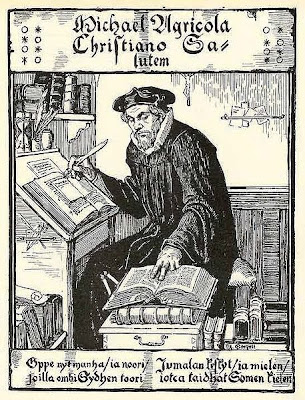Posted on April 9, 2021
This is an update of my post published on April 9, 2010:

As soon as I saw mention of this holiday, I wondered: Why would the anniversary of the death of a clergyman be celebrated as a day honoring an entire language?
It turns out, Mikael Agricola is “the father of the Finnish written language.”
Agricola wrote an “ABC book” that served as a primer for reading and that set out the rules that are the basis of modern Finnish spelling. He then went on to translate the New Testament, prayerbooks, hymns, three liturgical books, and the mass into Finnish. And he did all that in just three years!
In addition to “merely” inventing a written language and doing a whole lot of translation, Agricola was in favor of bringing the Protestant Reformation to Finland, and he wrote some of his opinions as introductions in his prayer books.
Sadly, Agricola died suddenly at age 47 while he was returning from a trip to Russia, where he helped negotiate a peace treaty. It is the day that he died, April 9, 1557, that is commemora
ted as Finnish Language Day.Agricola invented written Finnish? Wow!
At the time that Agricola created written Finnish, Finland was ruled by Sweden – and had been for more than 200 years. Educated Finns spoke, read, and wrote Swedish and perhaps other languages. (Agricola learned Greek, German, and Latin as well as Finnish and Swedish.)
Agricola wanted every Finn to be able to read religious books, especially the Bible, fo
r themselves. That is why he worked to invent a way in which the sounds of Finnish could map onto a modified Roman alphabet (basically the same alphabet we English-speakers use).However, with upper class children still being educated in Swedish, written Finnish didn’t blossom until the 1800s. At that time, people began to feel patriotic about all things Finnish, and a man named Elias Lönnrot (who was, coincidentally, born on the same day that Mikael Agricola died, but 245 years later!) collected Finnish folk tales and published them in Finnish.
Finally, in
1892, the Finnish language gained equal status with Swedish in Finland.Did anyone else ever invent a written language?
The invention of writing of most languages was presumably carried out by many people, and in any case we do not know the inventors’ names because it happened so very long ago. But there are some languages, other than Finnish, that weren’t written until relatively recently.
Norwegian
– a latecomer to written language, but now there are TWO!Norwegian is fairly similar to Danish and Swedish, and the people of Norway didn’t have a written form of their own language until about 150 years ago, because those who were literate used Danish. In the last century and a half, however, two different written Norwegian languages developed! Both are official languages, both are used in government, schools, churches, newspapers, and magazines. Students learn both (some learn Bokmal as their primary and Nynorsk as their secondary written languages, and others vice versa).
In 1821, Sequoyah (AKA Ssiquoya, Se-quo-ya, George Gist, or Guess) completed 12 years of work on the creation of a writing system for the Cherokee language. This is considered the only time in history that an illiterate member of a culture that had no written language has independently created an effective writing system. (Sequoyah had seen English and some other written languages but didn’t know how to read those languages. He used many Roman, Cyrillic, and Greek letters, and Arabic numerals, for his written language—but in his system the symbols have no connection to the sounds or names of those letters and numerals in their original languages.)
Sequoyah created a syllabary of 86 symbols that stood for different Cherokee syllables. If we were producing a syllabary for English, we could use “>” for ba, “<” for ca, and “#” for da, for example. We would need a lot of different symbols for all the syllables English-speakers use!
Unlike Agricola’s invention, written Cherokee caught on right away. Within just four years, the Cherokee Nation officially adopted the writing system, a newspaper sprang up two years after that, and the literacy rate of the Cherokee soon outstripped that of their white American settler neighbors.
 |
| The Code Talkers are honored every August 14. |
Navajo has only four vowels, but each has up to 10 intonations—and a different intonation means a different word. Because it is so complicated, Navajo cannot be written with normal Roman letters (the ones used by English-speakers), and Navajo did not have a standardized alphabet until 1939.
When the United States entered World War II, it was decided that this complicated language (little known by outsiders of the Navajo community) would make a good code for radio transmissions.
The Marines recruited Indians who spoke Navajo and English, and sure enough, the code talkers (as they were called) provided an invaluable service to their country.
The Japanese were never able to break the code, and one important reason may have been the lack of written Navajo materials.
Some of the first inventors of written language
The ancient Sumerians developed one of the earliest forms of writing. Read about it here.
 |
| You can see on this map why Finland shares bits of its culture and language with Norway, Sweden, Denmark, Russia, and the Baltic nations (Estonia, Latvia, and Lithuania). |
Do you want to try some Finnish food? How about
sautéed reindeer, salmon soup, and blood pancakes? Or…maybe you’d like a nice Finnish trifle or cinnamon bun.There are Finnish nursery rhymes and lyrics to Finnish kids’ songs on Mama Lisa’s website, and the flag and map of Finland on the Enchanted Learning website.
Also on this date:
Plan ahead:
Check out my Pinterest boards for:
-
April holidays
-
April birthdays
-
Historical anniversaries in April
-
May holidays
-
May birthdays
-
Historical anniversaries in May

























